Abstract
1. The increase in rate of heat production caused by stretch in the unstimulated frog's sartorius (stretch response) has been measured using a conventional thermopile technique.
2. The rate of heat production was found constant between l0 (the distance in vivo between the tendons when the legs were in a straight line) and 1·2 l0, and rose rapidly above this length to reach 3-5 times the basal rate at 1·3 l0. Stretching to greater lengths appeared to damage the muscles.
3. The stretch response is increased by several substances which increase the duration of the active state.
4. Unlike the rate of heat production at l0, the stretch response is increased by procaine; while the presence of CO2 greatly reduces it.
5. Evidence is presented supporting the hypothesis that the stretch response is associated with the appearance of tension in the sarcolemma.
Full text
PDF
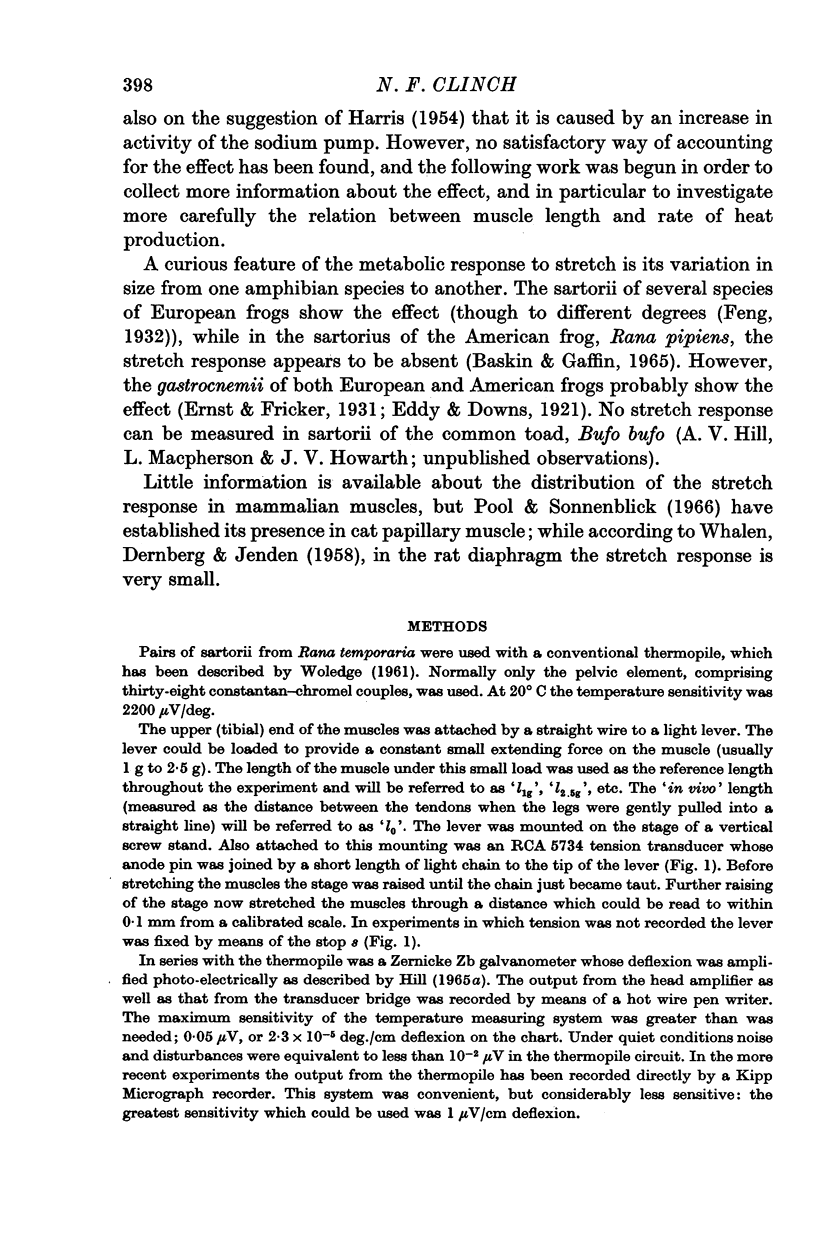
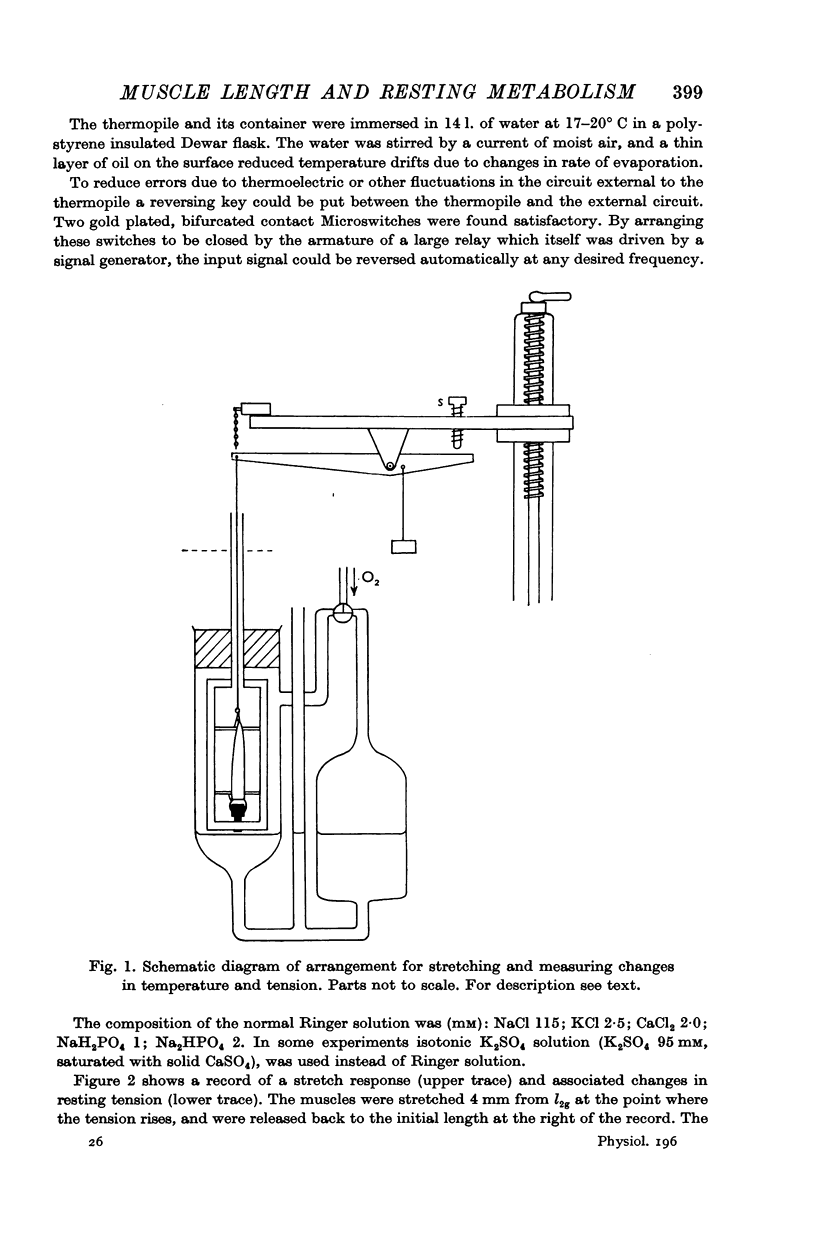
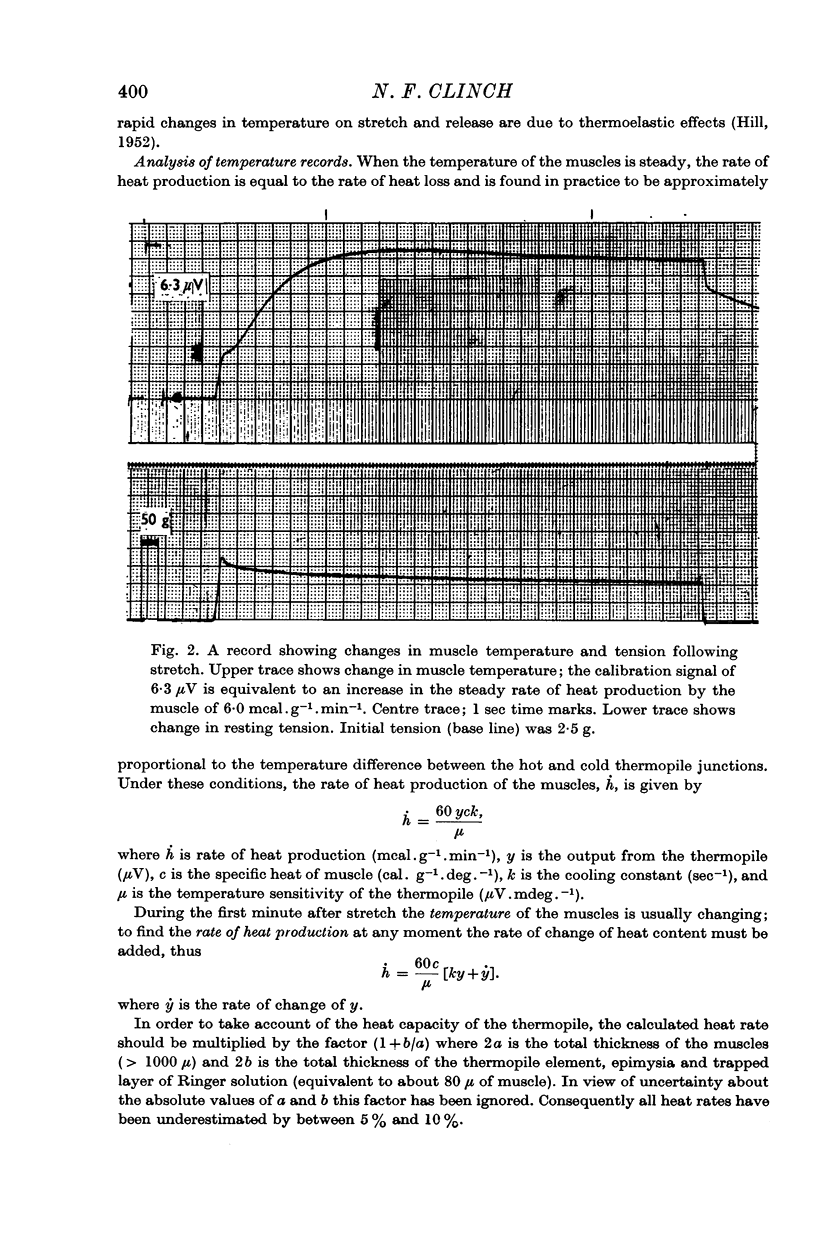

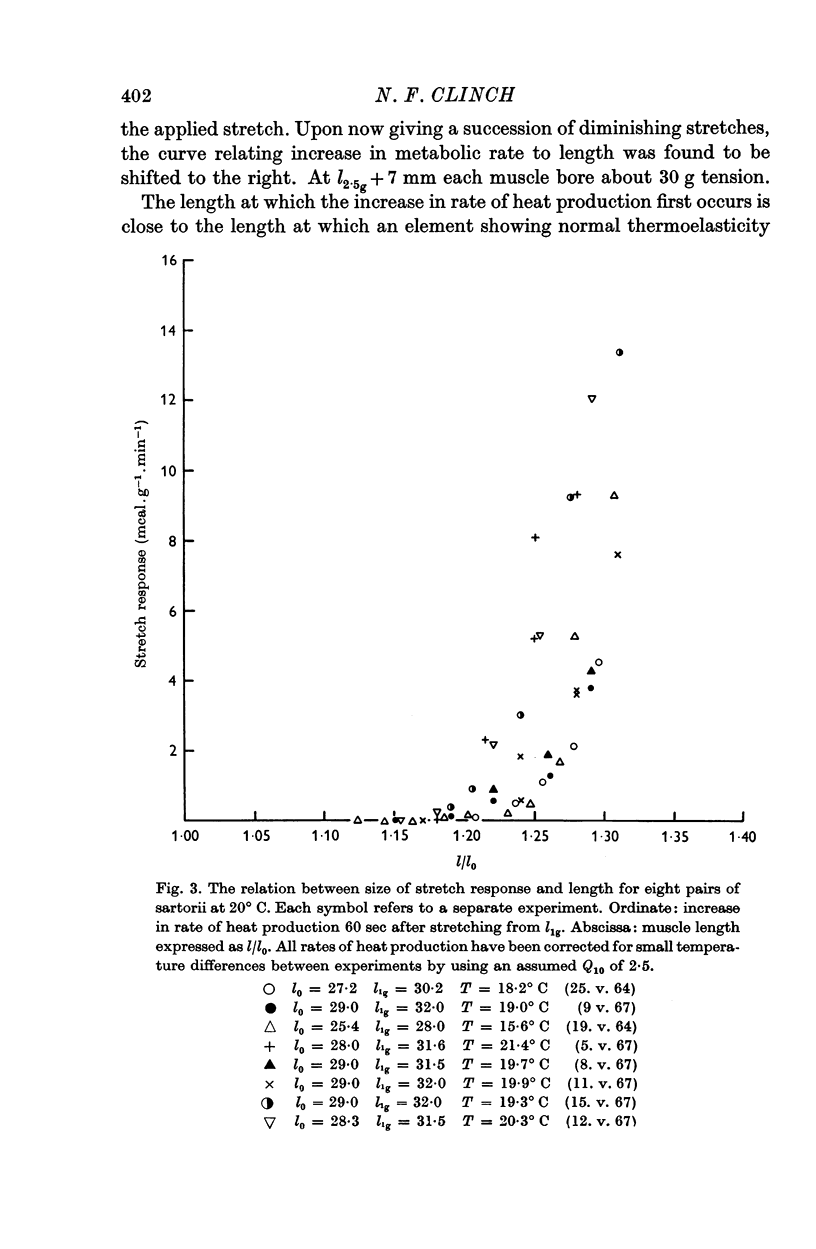
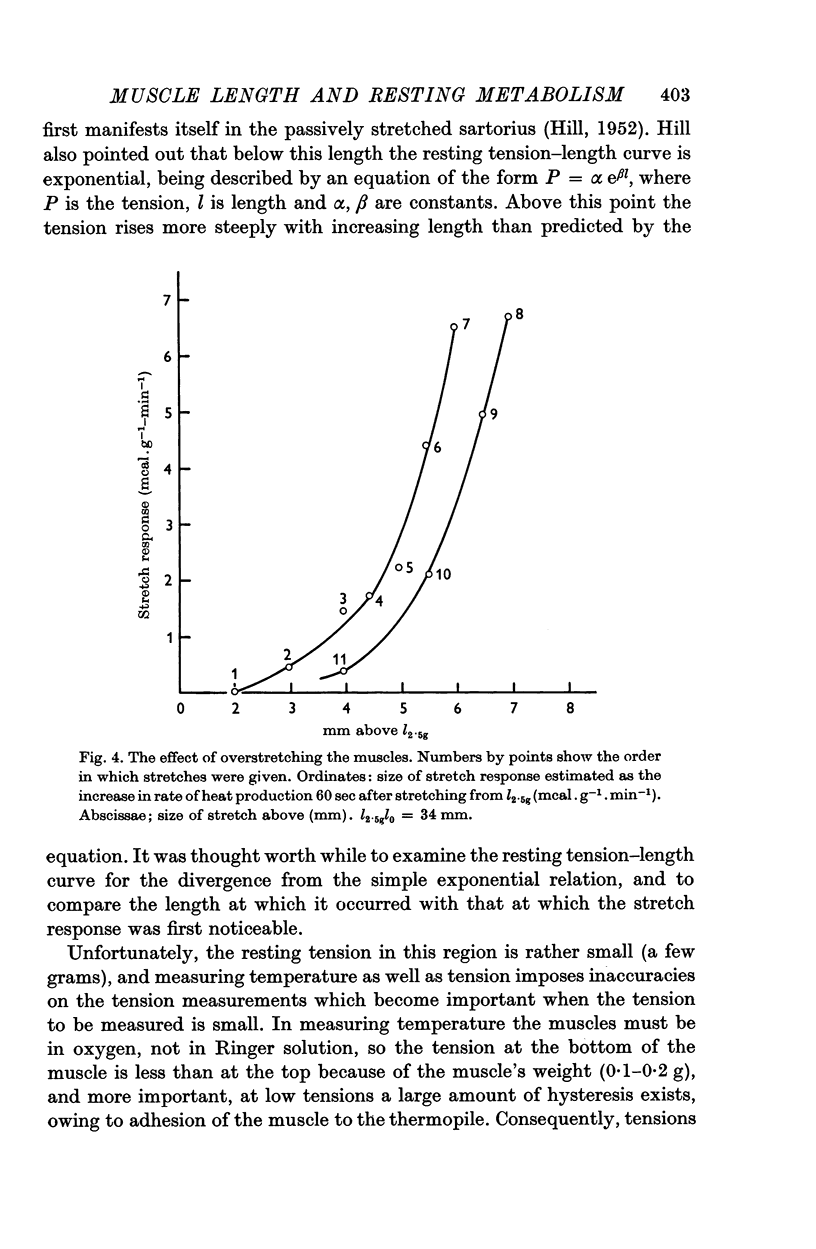
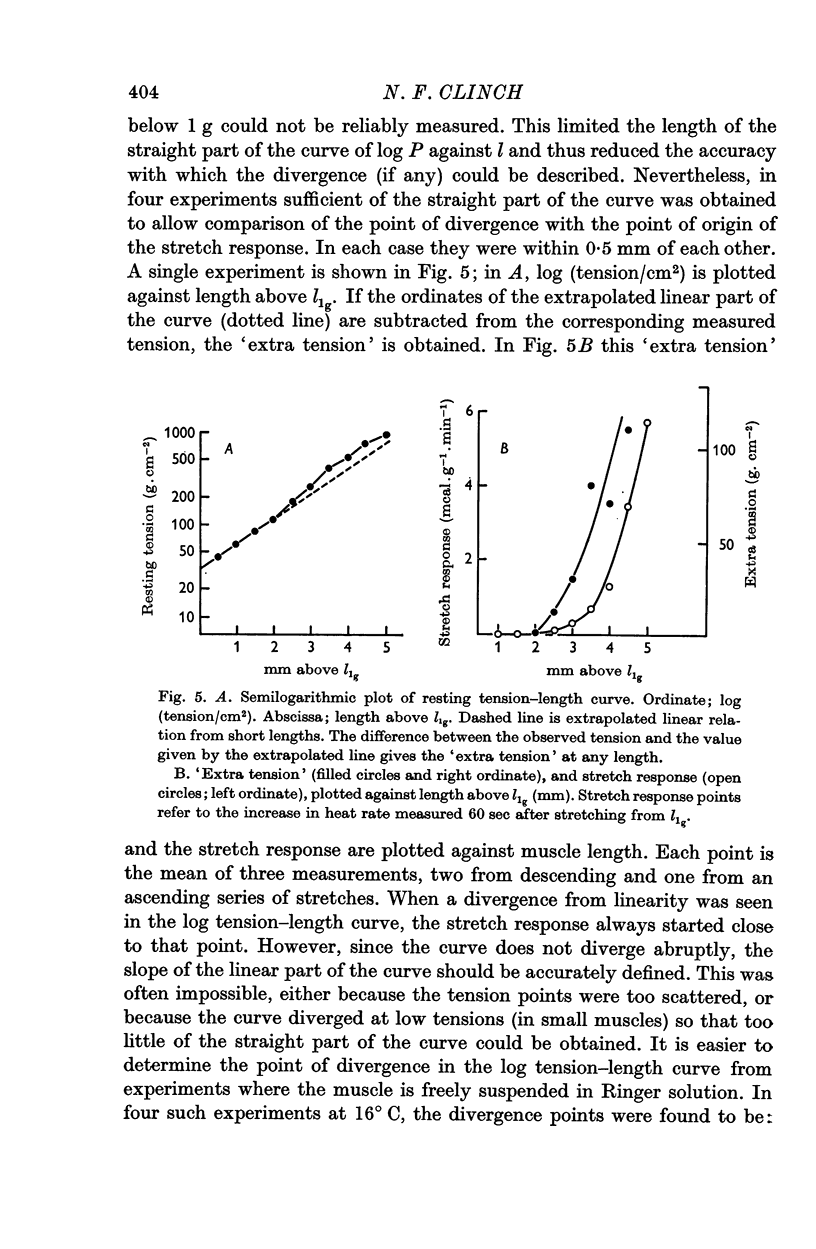
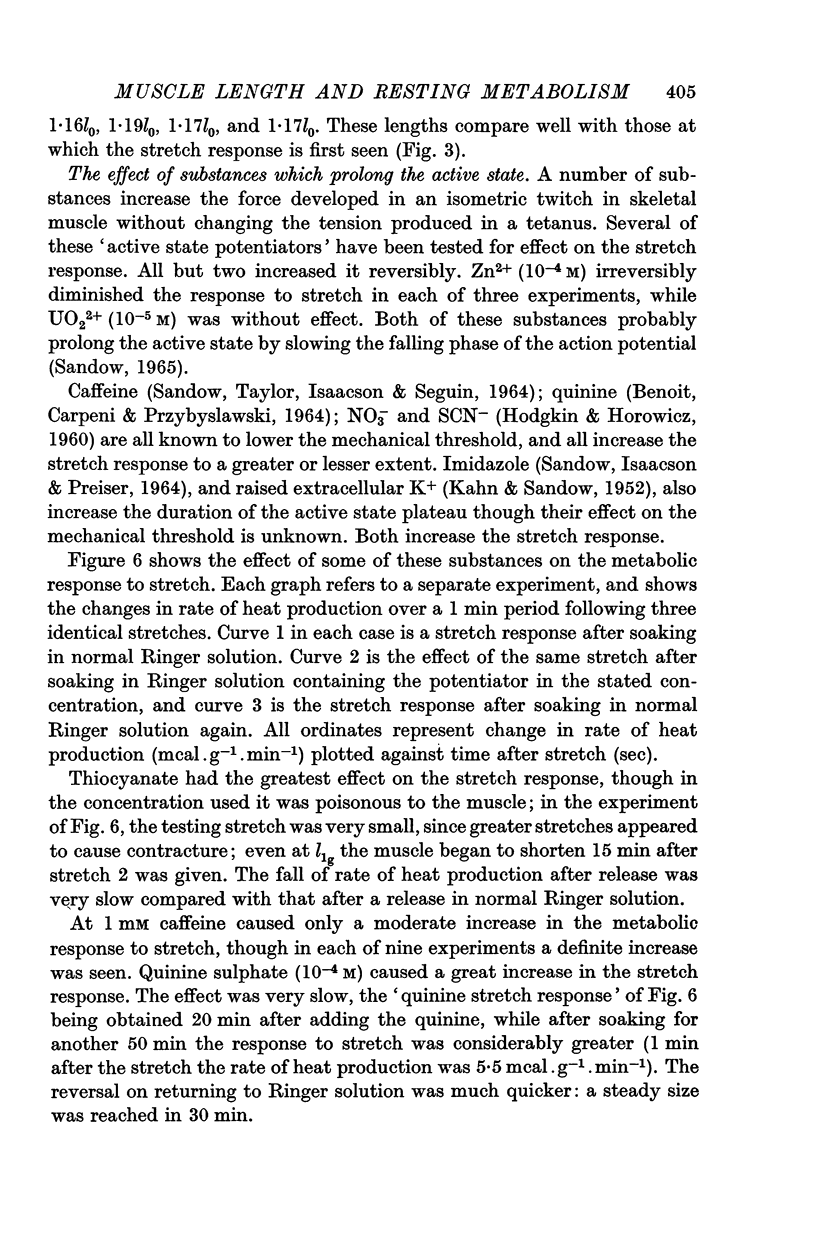




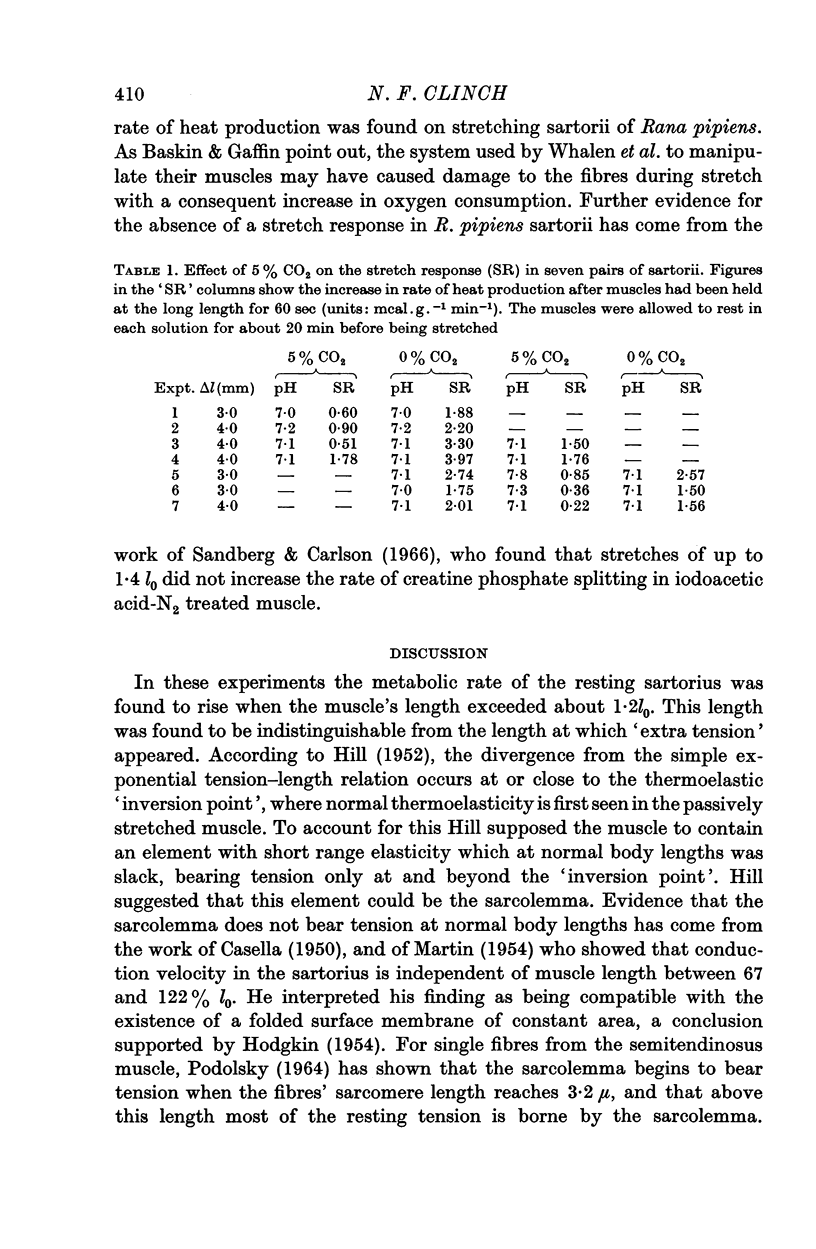

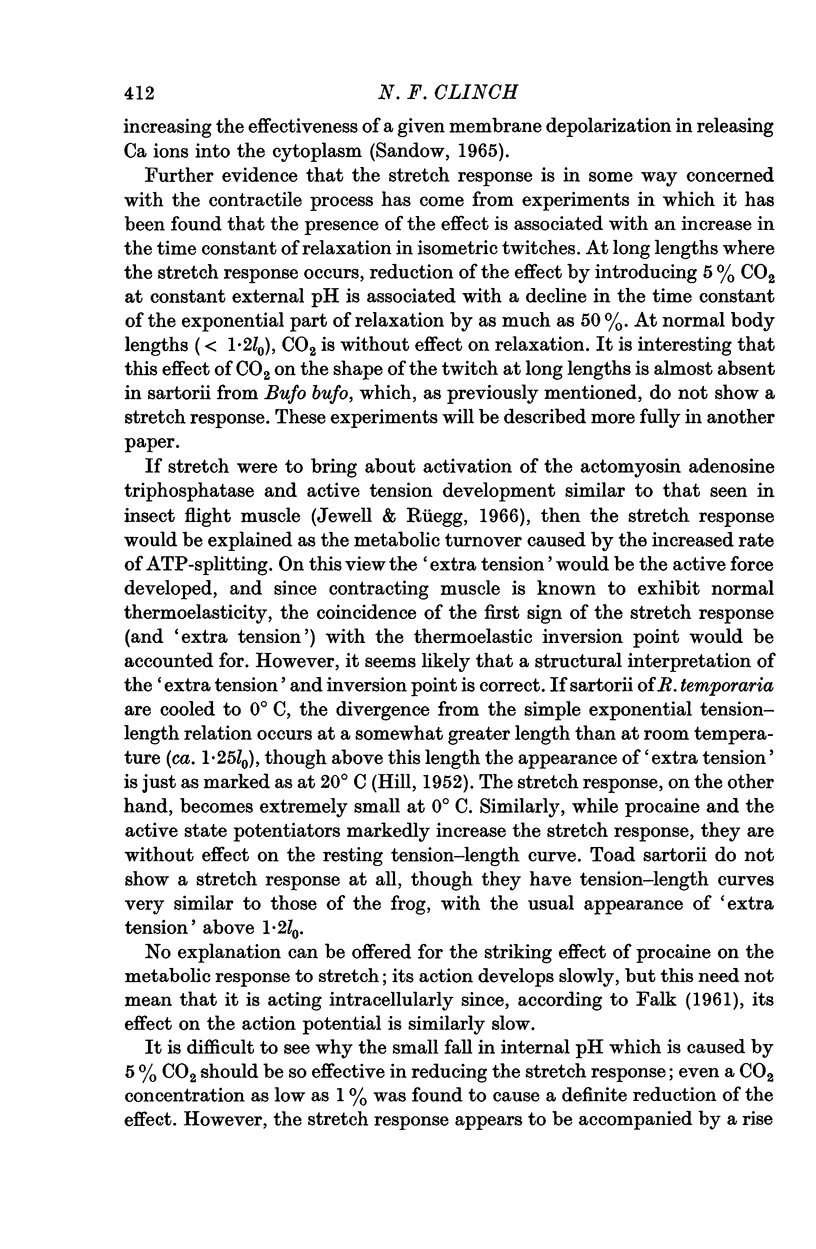
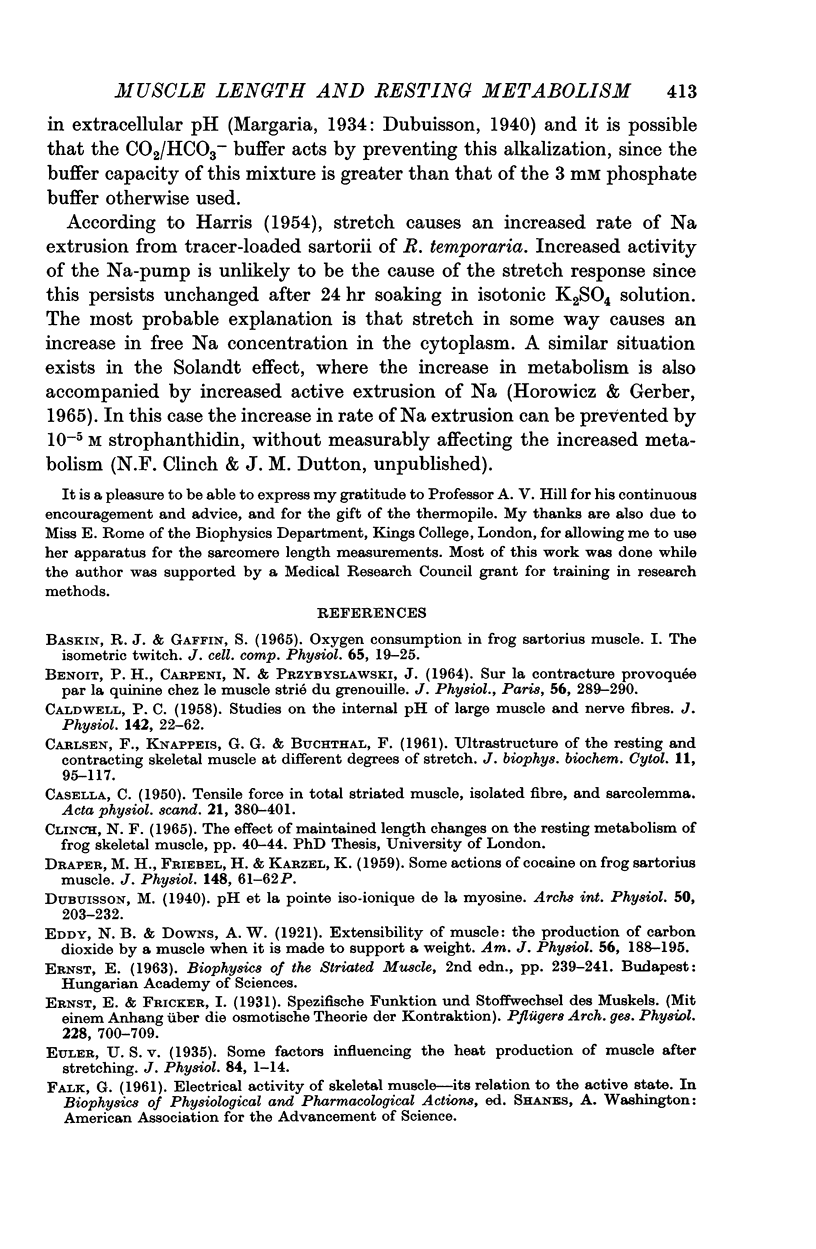
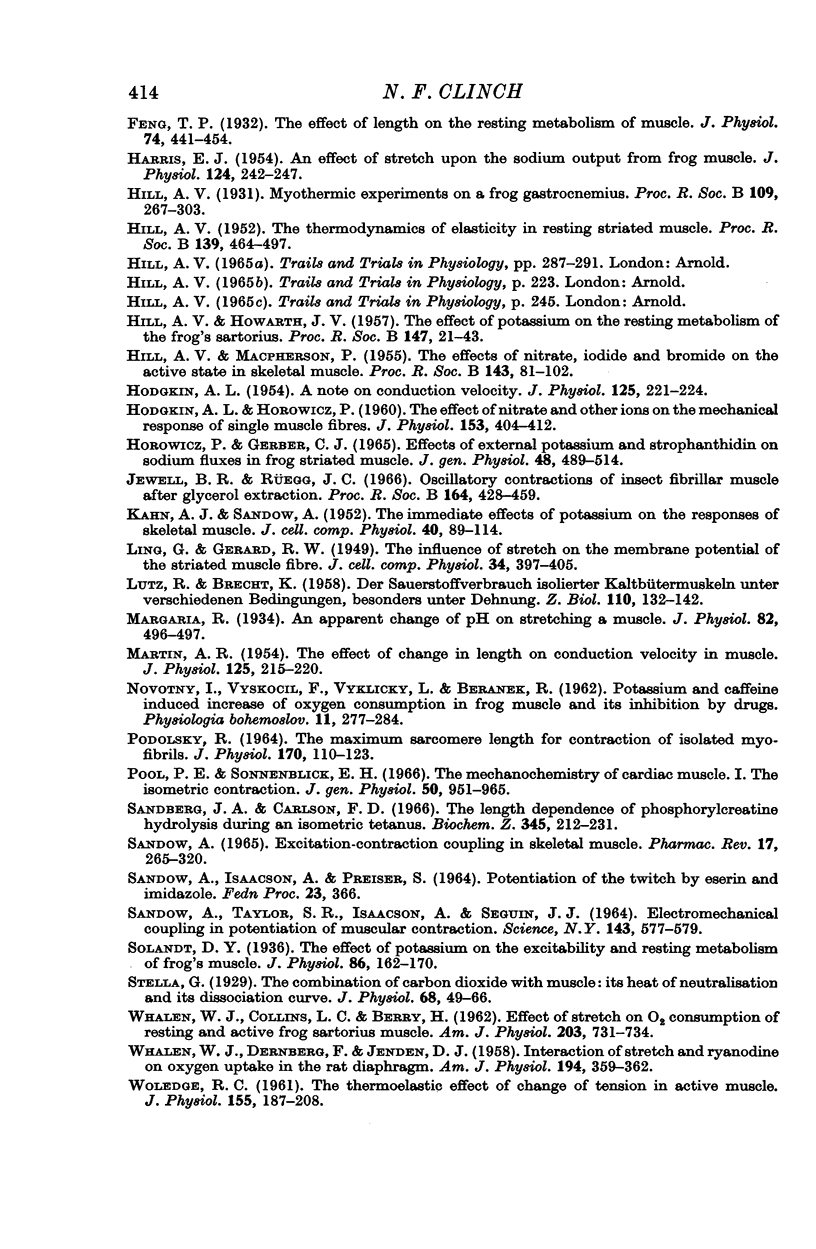
Images in this article
Selected References
These references are in PubMed. This may not be the complete list of references from this article.
- BASKIN R. J., GAFFIN S. OXYGEN CONSUMPTION IN FROG SARTORIUS MUSCLE. I. THE ISOMETRIC TWITCH. J Cell Physiol. 1965 Feb;65:19–25. doi: 10.1002/jcp.1030650104. [DOI] [PubMed] [Google Scholar]
- BENOIT P. H., CARPENI N., PRZYBYSLAWSKI J. SUR LA CONTRACTURE PROVOQU'EE PAR LA QUININE CHEZ LE MUSCLE STRI'E DE GRENOUILLE. J Physiol (Paris) 1964 May-Jun;56:289–290. [PubMed] [Google Scholar]
- CALDWELL P. C. Studies on the internal pH of large muscle and nerve fibres. J Physiol. 1958 Jun 18;142(1):22–62. doi: 10.1113/jphysiol.1958.sp005998. [DOI] [PMC free article] [PubMed] [Google Scholar]
- CARLSEN F., KNAPPEIS G. G., BUCHTHAL F. Ultrastructure of the resting and contracted striated muscle fiber at different degrees of stretch. J Biophys Biochem Cytol. 1961 Oct;11:95–117. doi: 10.1083/jcb.11.1.95. [DOI] [PMC free article] [PubMed] [Google Scholar]
- CASELLA C. Tensile force in total striated muscle, isolated fibre and sarcolemma. Acta Physiol Scand. 1950 Dec;21(4):380–401. doi: 10.1111/j.1748-1716.1950.tb00744.x. [DOI] [PubMed] [Google Scholar]
- Feng T. P. The effect of length on the resting metabolism of muscle. J Physiol. 1932 Apr 26;74(4):441–454. doi: 10.1113/jphysiol.1932.sp002860. [DOI] [PMC free article] [PubMed] [Google Scholar]
- HARRIS E. J. An effect of stretch upon the sodium output from frog muscle. J Physiol. 1954 May 28;124(2):242–247. doi: 10.1113/jphysiol.1954.sp005103. [DOI] [PMC free article] [PubMed] [Google Scholar]
- HILL A. V., HOWARTH J. V. The effect of potassium on the resting metabolism of the frog's sartorius. Proc R Soc Lond B Biol Sci. 1957 Aug 24;147(926):21–43. doi: 10.1098/rspb.1957.0034. [DOI] [PubMed] [Google Scholar]
- HILL A. V., MACPHERSON L. The effect of nitrate, iodide and bromide on the duration of the active state in skeletal muscle. Proc R Soc Lond B Biol Sci. 1954 Dec 15;143(910):81–102. doi: 10.1098/rspb.1954.0055. [DOI] [PubMed] [Google Scholar]
- HILL A. V. The thermodynamics of elasticity in resting striated muscle. Proc R Soc Lond B Biol Sci. 1952 Jul 10;139(897):464–passim. doi: 10.1098/rspb.1952.0024. [DOI] [PubMed] [Google Scholar]
- HODGKIN A. L. A note on conduction velocity. J Physiol. 1954 Jul 28;125(1):221–224. doi: 10.1113/jphysiol.1954.sp005152. [DOI] [PMC free article] [PubMed] [Google Scholar]
- HODGKIN A. L., HOROWICZ P. The effect of nitrate and other anions on the mechanical response of single muscle fibres. J Physiol. 1960 Sep;153:404–412. doi: 10.1113/jphysiol.1960.sp006542. [DOI] [PMC free article] [PubMed] [Google Scholar]
- HOROWICZ P., GERBER C. J. EFFECTS OF EXTERNAL POTASSIUM AND STROPHANTHIDIN ON SODIUM FLUXES IN FROG STRIATED MUSCLE. J Gen Physiol. 1965 Jan;48:489–514. doi: 10.1085/jgp.48.3.489. [DOI] [PMC free article] [PubMed] [Google Scholar]
- LING G., GERARD R. W. The influence of stretch on the membrane potential of the striated muscle fiber. J Cell Physiol. 1949 Dec;34(3):397–405. doi: 10.1002/jcp.1030340305. [DOI] [PubMed] [Google Scholar]
- LUTZ E., BRECHT K. Der Sauerstoffverbrauch isolierter Kaltblütermuskeln unter verschiedenen Bedingungen, besonders unter Dehnung. Z Biol. 1958 Apr;110(2):132–142. [PubMed] [Google Scholar]
- MARTIN A. R. The effect of change in length on conduction velocity in muscle. J Physiol. 1954 Jul 28;125(1):215–220. doi: 10.1113/jphysiol.1954.sp005151. [DOI] [PMC free article] [PubMed] [Google Scholar]
- Margaria R. An apparent change of ph on stretching a muscle. J Physiol. 1934 Nov 12;82(4):496–497. doi: 10.1113/jphysiol.1934.sp003201. [DOI] [PMC free article] [PubMed] [Google Scholar]
- NOVOTNY I., VYSKOCIL F., VYKLICKY L., BERANEK R. Potassium and caffeine induced increase of oxygen consumption in frog muscle and its inhibition by drugs. Physiol Bohemoslov. 1962;11:277–284. [PubMed] [Google Scholar]
- PODOLSKY R. J. THE MAXIMUM SARCOMERE LENGTH FOR CONTRACTION OF ISOLATED MYOFIBRILS. J Physiol. 1964 Jan;170:110–123. doi: 10.1113/jphysiol.1964.sp007317. [DOI] [PMC free article] [PubMed] [Google Scholar]
- Pool P. E., Sonnenblick E. H. The mechanochemistry of cardiac muscle. I. The isometric contraction. J Gen Physiol. 1967 Mar;50(4):951–965. doi: 10.1085/jgp.50.4.951. [DOI] [PMC free article] [PubMed] [Google Scholar]
- SANDOW A., KAHN A. J. The immediate effects of potassium on responses of skeletal muscle. J Cell Physiol. 1952 Aug;40(1):89–114. doi: 10.1002/jcp.1030400107. [DOI] [PubMed] [Google Scholar]
- SANDOW A., TAYLOR S. R., ISAASON A., SEGUIN J. J. ELECTROCHEMICAL COUPLING IN POTENTIATION OF MUSCULAR CONTRACTION. Science. 1964 Feb 7;143(3606):577–579. doi: 10.1126/science.143.3606.577. [DOI] [PubMed] [Google Scholar]
- Sandow A. Excitation-contraction coupling in skeletal muscle. Pharmacol Rev. 1965 Sep;17(3):265–320. [PubMed] [Google Scholar]
- Solandt D. Y. The effect of potassium on the excitability and resting metabolism of frog's muscle. J Physiol. 1936 Feb 8;86(2):162–170. doi: 10.1113/jphysiol.1936.sp003351. [DOI] [PMC free article] [PubMed] [Google Scholar]
- Stella G. The combination of carbon dioxide with muscle: its heat of neutralization and its dissociation curve. J Physiol. 1929 Aug 28;68(1):49–66. doi: 10.1113/jphysiol.1929.sp002595. [DOI] [PMC free article] [PubMed] [Google Scholar]
- V Euler U. S. Some factors influencing the heat production of muscle after stretching. J Physiol. 1935 Apr 26;84(1):1–14. doi: 10.1113/jphysiol.1935.sp003251. [DOI] [PMC free article] [PubMed] [Google Scholar]
- WHALEN W. J., COLLINS L. C., BERRY H. Effect of stretch on O2 consumption of resting and active frog sartorius muscle. Am J Physiol. 1962 Oct;203:731–734. doi: 10.1152/ajplegacy.1962.203.4.731. [DOI] [PubMed] [Google Scholar]
- WHALEN W. J., DERNBERG E., JENDEN D. J. Interaction of stretch and ryanodine on oxygen uptake in the rat diaphragm. Am J Physiol. 1958 Aug;194(2):359–362. doi: 10.1152/ajplegacy.1958.194.2.359. [DOI] [PubMed] [Google Scholar]
- WOLEDGE R. C. The thermoelastic effect of change of tension in active muscle. J Physiol. 1961 Jan;155:187–208. doi: 10.1113/jphysiol.1961.sp006622. [DOI] [PMC free article] [PubMed] [Google Scholar]



